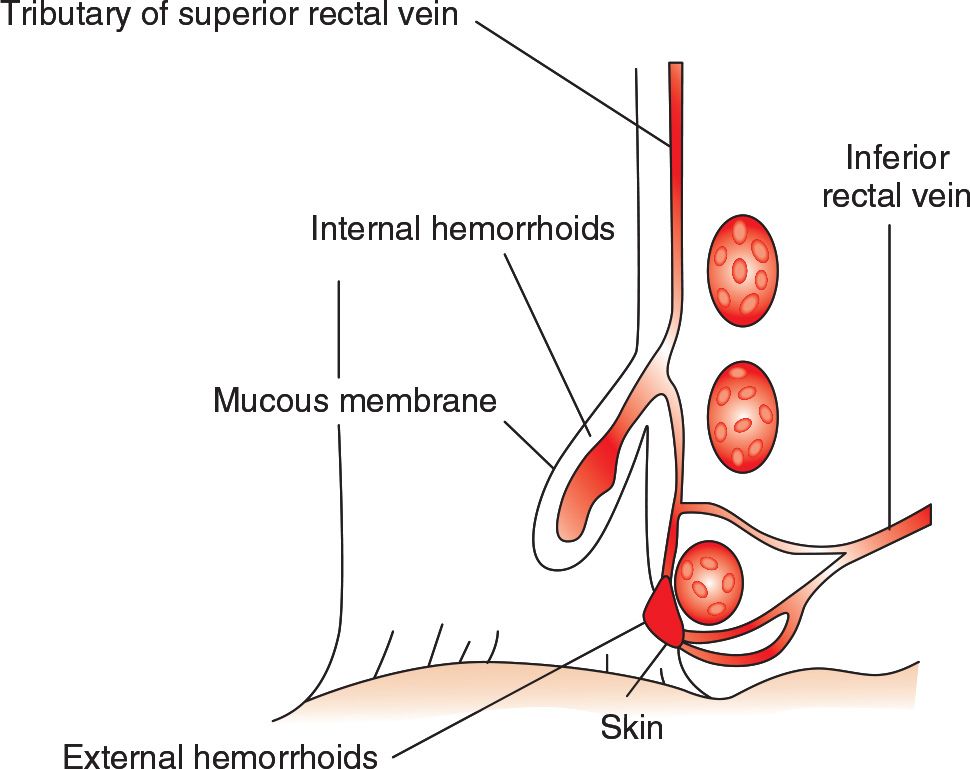![]() A thrombosed, painful external hemorrhoid that has been symptomatic for less than 72 hours, not improved with conservative measures
A thrombosed, painful external hemorrhoid that has been symptomatic for less than 72 hours, not improved with conservative measures
![]() Decision to excise should also be based on severity of pain and clinical course. If the patient presents with improving pain, medical management is likely preferable.
Decision to excise should also be based on severity of pain and clinical course. If the patient presents with improving pain, medical management is likely preferable.
![]() After 72 hours, most patients have decreased pain and spontaneous resolution of symptoms
After 72 hours, most patients have decreased pain and spontaneous resolution of symptoms
CONTRAINDICATIONS
![]() Relative Contraindications
Relative Contraindications
![]() Inflammatory bowel disease—high rate of fistula formation
Inflammatory bowel disease—high rate of fistula formation
![]() Perianal infection
Perianal infection
![]() Known coagulopathy
Known coagulopathy
![]() Portal hypertension
Portal hypertension
LANDMARKS
![]() Internal hemorrhoids originate above the dentate line
Internal hemorrhoids originate above the dentate line
![]() Can prolapse and extend outside the anal canal (FIGURE 33.1)
Can prolapse and extend outside the anal canal (FIGURE 33.1)
![]() External hemorrhoids originate below the dentate line
External hemorrhoids originate below the dentate line
![]() General Basic Steps
General Basic Steps
![]() Prepare patient
Prepare patient
![]() Anesthetize
Anesthetize
![]() Incise
Incise
![]() Remove clot
Remove clot
![]() Pack wound
Pack wound
TECHNIQUE
![]() Patient Preparation
Patient Preparation
![]() Place the patient in the prone jackknife or left lateral decubitus position
Place the patient in the prone jackknife or left lateral decubitus position
![]() For prone jackknife positioning, place rolled towels beneath the patient’s pelvis to elevate buttocks
For prone jackknife positioning, place rolled towels beneath the patient’s pelvis to elevate buttocks
![]() Gently spread the buttocks and maintain the positioning with tape
Gently spread the buttocks and maintain the positioning with tape
![]() Prepare the area with povidone–iodine solution (Betadine) using sterile gloves
Prepare the area with povidone–iodine solution (Betadine) using sterile gloves
![]() Inject 1% lidocaine with epinephrine or 0.5% bupivacaine into the base of the thrombosed hemorrhoid
Inject 1% lidocaine with epinephrine or 0.5% bupivacaine into the base of the thrombosed hemorrhoid
![]() Avoid multiple injection sites to decrease bleeding
Avoid multiple injection sites to decrease bleeding
![]() Topical lidocaine gel can be used in the anal canal to supplement local anesthesia
Topical lidocaine gel can be used in the anal canal to supplement local anesthesia
![]() Intravenous analgesia is highly recommended
Intravenous analgesia is highly recommended
![]() Alternatively, a perianal block can be performed by injecting a local anesthetic into the sphincter complex in the anterior, posterior, and lateral positions
Alternatively, a perianal block can be performed by injecting a local anesthetic into the sphincter complex in the anterior, posterior, and lateral positions
![]() Incision
Incision
![]() Test the adequacy of the local anesthesia by grasping the hemorrhoid with forceps
Test the adequacy of the local anesthesia by grasping the hemorrhoid with forceps
![]() Using a no. 15 scalpel blade, make an elliptical incision around the thrombosis with the long axis in the radial direction relative to the anus
Using a no. 15 scalpel blade, make an elliptical incision around the thrombosis with the long axis in the radial direction relative to the anus
![]() Never incise in a circumferential axis
Never incise in a circumferential axis
![]() Control bleeding with direct pressure
Control bleeding with direct pressure
![]() Elevate skin edges with a forceps and excise to expose underlying thrombus
Elevate skin edges with a forceps and excise to expose underlying thrombus
![]() Remove the clot and any overlying skin using a forceps or by applying pressure
Remove the clot and any overlying skin using a forceps or by applying pressure
![]() After the clot is removed, have an assistant spread the incision, exposing the base of the hemorrhoid to allow visualization and removal of additional clots
After the clot is removed, have an assistant spread the incision, exposing the base of the hemorrhoid to allow visualization and removal of additional clots
![]() If significant bleeding occurs that is not controlled with direct pressure, hemostasis can be achieved with a suture or silver nitrate
If significant bleeding occurs that is not controlled with direct pressure, hemostasis can be achieved with a suture or silver nitrate
![]() Pack the wound loosely with standard cotton gauze or iodoform packing to prevent skin edges from reapproximating prematurely, and apply a pressure dressing
Pack the wound loosely with standard cotton gauze or iodoform packing to prevent skin edges from reapproximating prematurely, and apply a pressure dressing
![]() Follow-up Care
Follow-up Care
![]() Counsel the patient to apply direct pressure if bleeding occurs
Counsel the patient to apply direct pressure if bleeding occurs
![]() Dressing may be removed after 12 hours, at which point the patient should begin taking sitz baths three to four times daily
Dressing may be removed after 12 hours, at which point the patient should begin taking sitz baths three to four times daily
![]() Prescribe stool softeners and fiber supplements as needed. Avoid opiate pain medication, and instruct the patient to increase oral fluid intake.
Prescribe stool softeners and fiber supplements as needed. Avoid opiate pain medication, and instruct the patient to increase oral fluid intake.
![]() Follow-up should be arranged in 2 to 4 weeks. The patient must return sooner if he or she experiences severe pain, uncontrolled bleeding, or signs of infection.
Follow-up should be arranged in 2 to 4 weeks. The patient must return sooner if he or she experiences severe pain, uncontrolled bleeding, or signs of infection.

FIGURE 33.1 Varicosed tributary of the superior rectal vein forming the internal hemorrhoid. (From Snell RS. Clinical anatomy, 7th ed. Philadelphia: Lippincott Williams & Wilkins; 2004:427, with permission).
Stay updated, free articles. Join our Telegram channel

Full access? Get Clinical Tree


